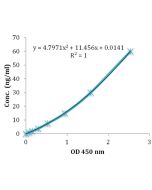Cookie Policy: This site uses cookies to improve your experience. You can find out more about our use of cookies in our Privacy Policy. By continuing to browse this site you agree to our use of cookies.
AdipoGen Life Sciences
Zinc-α-2-glycoprotein (human) (rec.) (untagged)

| Product Details | |
|---|---|
| Synonyms | Zn-α-2-GP; Zn-α-2-Glycoprotein; ZAG; ZA2G; AZGP1; ZNGP1 |
| Product Type | Protein |
| Properties | |
| Source/Host | E. coli |
| Sequence |
Human full-length zinc-α-2-glycoprotein (aa 21-298) is untagged. |
| Crossreactivity | Human |
| MW | ~30kDa |
| Purity | ≥95% (SDS-PAGE) |
| Endotoxin Content | <0.1EU/μg purified protein (LAL test). |
| Concentration |
10μg size: 0.1mg/ml after reconstitution. 50μg size: 1mg/ml after reconstitution. |
| Reconstitution |
10μg size: Reconstitute with 100μl sterile water. 50μg size: Reconstitute with 50μl sterile water. |
| Formulation | Lyophilized. Contains PBS. |
| Other Product Data |
Uni-Prot link P25311: Zinc-α-2-glycoprotein (human) |
| Shipping and Handling | |
| Shipping | BLUE ICE |
| Short Term Storage | +4°C |
| Long Term Storage | -20°C |
| Handling Advice |
After reconstitution, prepare aliquots and store at -20°C. Avoid freeze/thaw cycles. Centrifuge lyophilized vial before opening and reconstitution. PBS containing at least 0.1% BSA should be used for further dilutions. |
| Use/Stability |
Stable for at least 6 months after receipt when stored at -20°C. Working aliquots are stable for up to 3 months when stored at -20°C. |
| Documents | |
| MSDS |
 Download PDF Download PDF |
| Product Specification Sheet | |
| Datasheet |
 Download PDF Download PDF |
Zinc-α-2-glycoprotein (ZAG), first identified in the 1960s, derives its name from its precipitation from human plasma upon the addition of zinc salts. ZAG has since been found in secretory epithelial cells and in a range of body fluids. ZAG is identical to a lipid mobilizing factor isolated from the urine of patients with cancer cachexia and stimulates lipolysis in in vitro and in vivo experiments. Due to its expression in, and secretion from adipocytes, ZAG is considered an adipokine. Recently the clinical significance of ZAG has been clarified. ZAG expression in adipocytes is inversely related to fat mass, thus it is intimately involved in the maintenance of body weight in mice and humans. Epidemiological studies have uncovered an association between ZAG and plasma cholesterol. The non-synonymous single nucleotide polymorphism rs4215 in ZAG is associated with plasma cholesterol and obesity. Structurally ZAG possesses a class I major histocompatibility complex (MHC) protein fold. It is distinct from other members of this protein family in that it is soluble, rather than being anchored to plasma membranes, and it associates with prolactin inducible protein rather than β2-microglobulin. Similar to peptide antigen-presenting class I MHC molecules, ZAG possesses an open apical groove between its α1 and α2 domain helices.
- Strong and weak zinc binding sites in human zinc-α2-glycoprotein: A.A. Kumar, et al.; FEBS Lett. 587, 3949 (2013)
- Zinc-induced oligomerization of zinc α2 glycoprotein reveals multiple fatty acid-binding sites: H. Zahid, et al.; Biochem. J. 473, 43 (2016)
- Identification of diverse lipid-binding modes in the groove of zinc α2 glycoprotein reveals its functional versatility: H. Zahid, et al.; FEBS J. 289, 1876 (2022)








